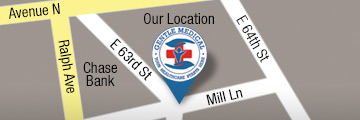Medical Treatment for Abdominal Pain
Posted by admin on October 6th, 2013

“Abdominal pain can have numerous causes. It can be difficult even for doctors to differentiate between serious and benign causes of abdominal pain. The abdomen contains many organs that can potentially cause problems. For this reason, it is always best to err on the side of caution. Most of the time abdominal pain is not serious, but when it is serious it is VERY serious. If you are experiencing abdominal pain, come in and see me.”
-Dr. Zimilevich, MD
What is abdominal pain?
Abdominal pain is any pain that occurs below the xiphoid process (the bottom tip of your sternum or breastbone) and above the pubic bone. It may be dull, sharp, constant, intermittent, stabbing or aching in nature. It may occur on its own or may be accompanied by other signs and symptoms, such as nausea and vomiting or fever. These accompanying signs and symptoms can provide clues as to what may be causing the problem.
What causes abdominal pain?
Abdominal pain can be caused by many issues affecting the organs found in the abdominal cavity, including:
- gynecological problems- in women pain may arise from problems affecting the uterus, ovaries or fallopian tubes
- the stomach- stomach viruses, food poisoning and ulcers are common problems affecting the stomach. Invariably, appetite will be affected. Nausea and vomiting may also occur. Pain in the stomach is often referred to as burning or gnawing pain. Chronic issues affecting the stomach may result in weight loss.
- the intestines- intestinal illnesses can cause a lot of discomfort. Pain may be constant or intermittent and may be sharp or dull. There may be accompanying signs and symptoms such as nausea, vomiting, blood in the stool, weight loss, rectal pain, inability to pass flatus (gas or wind) or fever. The location of the pain can also provide clues. Pain that is centered around the belly button is likely to be caused by a problem in the small bowel; intestinal pain arising from the large bowel may be felt all over as generalized tenderness. History and physical exam will provide other clues. Intestinal problems may be infectious (a viral or bacterial cause such as food poisoning), may be caused by inflammatory bowel disease, adhesions or blockage of the bowel.
- the appendix- the appendix is located in the right lower quadrant of the abdomen. Pain often begins around the belly button and may eventually move to the right lower side of the abdomen, midway between your hip bone and your belly button, known as McBurney’s point. If you have appendicitis, you will not have an appetite and you may be constipated. You may have a low-grade fever. Pain gradually worsens over time. Appendicitis is a surgical emergency. If you have symptoms of appendicitis, you should seek medical attention immediately.
- the pancreas- pancreatitis (inflammation of the pancreas) causes severe pain that will be difficult to ignore. The pain occurs in the upper abdomen and may radiate through to the back. Pancreatitis may also cause nausea and a low-grade fever. People with pancreatitis feel very ill. Gall stones or alcohol may precipitate an attack of pancreatitis.
- the gallbladder- gallstones or infection of the gallbladder can cause severe pain that is usually felt in the upper abdomen and may radiate to the back. Gallstones may block the bile duct, causing intense pain that may occur after eating a heavy or fatty meal. The pain usually subsides within a few hours but may reoccur again. Nausea and vomiting may occur.
- urinary tract problems- infection in the urinary tract (bladder or kidneys) may cause abdominal pain. Kidney infection or stones often cause severe pain that is felt in the flank area (just below the ribs and beside the spine on the affected side). Nausea and vomiting may occur. Fever will occur with infection. Testing the urine may reveal infection or blood in the urine.
- diverticular disease- the colon may develop weakened areas of the muscular wall that bulge out, allowing waste to collect in these areas. When these pockets develop infection, symptoms will include lower left abdominal pain, fever and flu-like symptoms. Diverticulitis requires antibiotics.
These are some of the common problems that may cause abdominal pain- there are many more. As you can see, the many organs of the abdomen present a challenge to diagnosis!
E
What can I expect when I come in to see you?
When you come in to see me with abdominal pain, I will first ask you about your past medical history, including any surgeries you may have had. I will also ask about family history and medications you are taking.
I will ask you about your symptoms. When did they start? Where is the pain? What is the nature of the pain (i.e. sharp or dull)? Is the pain constant, or does it come and go? Does the pain radiate (move) to other areas? What other symptoms are you experiencing (i.e. diarrhea, vomiting, fever)?
Once I have a handle on your symptoms, I will examine you, focusing on your abdomen. I will listen to your bowel sounds. I will also palpate (feel) your abdomen for areas of tenderness, swelling or masses. I will be paying attention to where your abdomen hurts the most. Once I have examined you and discussed your symptoms, I will likely order tests, which may include blood tests, an abdominal x-ray and urinalysis. I may order other tests as I see necessary.
Based on all of the information gathered, I will probably have a good idea as to what may be causing your abdominal pain and we can discuss what treatment is necessary to relieve your pain. If I cannot determine the source of your pain, I may refer you to a gastroenterologist.
If you are experiencing abdominal pain, make an appointment to see me. Some conditions that cause abdominal pain are benign, but others may be very serious and require immediate care. Make your appointment today.
Our Location

6301 Mill Lane, Brooklyn, NY 11234.
(718) 942-4600



